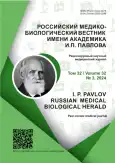Age-Related Features of Clinical and Neurological Characteristics and Pathogenetic Therapy in Patients with Multiple Sclerosis
- 作者: Molchanov I.P.1, Masaleva I.O.1, Karnaukhova E.N.2, Molchanova E.A.3
-
隶属关系:
- Kursk State Medical University
- Kursk Regional Multidisciplinary Clinical Hospital
- Kursk City Clinical Hospital No. 3
- 期: 卷 32, 编号 3 (2024)
- 页面: 433-444
- 栏目: Original study
- ##submission.dateSubmitted##: 22.05.2023
- ##submission.dateAccepted##: 14.09.2023
- ##submission.datePublished##: 04.10.2024
- URL: https://journals.eco-vector.com/pavlovj/article/view/450837
- DOI: https://doi.org/10.17816/PAVLOVJ450837
- ID: 450837
如何引用文章
详细
INTRODUCTION: Multiple sclerosis (MS) is a neurological demyelinating disease of the central nervous system manifested by pronounced heterogeneous symptoms. Peculiarities of the onset, progression rate, and severity of syndromes are different in different age groups. An increase in the frequency of exacerbations, high degree of disability of patients in different age groups evidence insufficient effectiveness of the conducted pathogenetic therapy. Due to a wide choice of multiple sclerosis disease modifying drugs (MSDMDs), it is important to study the clinical and neurological characteristics of patients with MS in different age groups with the aim of further developing an individual approach to treatment.
AIM: To study clinical and neurological features and effectiveness of pathogenetic therapy of MS in patients of different age groups.
MATERIALS AND METHODS: A prospective analysis of the data of neurological examination and results of magnetic resonance imaging of 100 patients of different age groups with relapsing-remitting MS, who received outpatient treatment in Kursk Regional Multidisciplinary Clinical Hospital, was conducted in the period of stable remission.
RESULTS: The leading syndromes in patients with relapsing-remitting course of MS were cerebellar (78%) and pyramidal (70%) syndromes, besides, dysfunction of the cranial nerves (71%) was also observed. A quantitative parameter of explicitness of pelvic disorder syndrome predominated in middle-aged and elderly patients compared to young ones (p < 0.001). Cognitive disorders were more often (14%) recorded in middle-aged and elderly patients (p < 0.001). The use of glatiramer acetate permitted to reduce the degree of disability in young subjects (p < 0.05); in patients of the middle age group, the most effective was a timely transition from interferon beta to ocrelizumab (p < 0.05). The use of first-line MSDMDs (interferon-beta) in elderly patients demonstrated low effectiveness (p < 0.05).
CONCLUSION: In middle-aged and elderly patients with equal timing of MS onset, the neurological deficit is more expressed than in young ones. First-line pathogenetic therapy, in particular, glatiramer acetate, is more effective in young patients, while patients of middle age are recommended an early transition to second-line MSDMDs.
全文:
作者简介
Ilya Molchanov
Kursk State Medical University
编辑信件的主要联系方式.
Email: molchanovlp@yandex.ru
ORCID iD: 0000-0001-9397-9913
SPIN 代码: 8279-0618
俄罗斯联邦, Kursk
Irina Masaleva
Kursk State Medical University
Email: masalevs@mail.ru
ORCID iD: 0000-0002-1002-524X
SPIN 代码: 2537-3678
MD, Cand. Sci. (Med.), Associate Professor
俄罗斯联邦, KurskElena Karnaukhova
Kursk Regional Multidisciplinary Clinical Hospital
Email: elena.carnauxowa@yandex.ru
ORCID iD: 0009-0007-0612-4628
SPIN 代码: 7819-3847
俄罗斯联邦, Kursk
Elena Molchanova
Kursk City Clinical Hospital No. 3
Email: len46mol@yandex.ru
ORCID iD: 0009-0004-0039-4801
俄罗斯联邦, Kursk
参考
- Møllgård K, Beinlich FRM, Kusk P, et al. Mesothelium divides the subarachnoid space into functional compartments. Science. 2023; 379(6627):84–8. doi: 10.1126/science.adc8810
- Zeydan B, Kantarci OH. Impact of Age on Multiple Sclerosis Disease Activity and Progression. Curr Neurol Neurosci Rep. 2020;20(7):24. doi: 10.1007/s11910-020-01046-2
- Bykova VA, Chernysh NA, Zarubaeva JS. Age-specific clinical features of multiple sclerosis. Nauchno-Meditsinskiy Vestnik Tsentral’-nogo Chernozem’ya. 2013;(53):62–6. Available at: http://medj.rucml.ru/journal/45562d434845524e4f5a454d534d422d41525449434c452d34363237/. Accessed: 2023 May 22. (In Russ).
- Kister I, Bacon T, Cutter GR. How Multiple Sclerosis Symptoms Vary by Age, Sex, and Race/Ethnicity. Neurol Clin Pract. 2021;11(4):335–41. doi: 10.1212/cpj.0000000000001105
- Conway BL, Zeydan B, Uygunoğlu U, et al. Age is a critical determinant in recovery from multiple sclerosis relapses. Mult Scler. 2019;25(13):1754–63. doi: 10.1177/1352458518800815
- Comi G, Radaelli M, Sørensen P.S. Evolving concepts in the treatment of relapsing multiple sclerosis. Lancet. 2017;389(10076):1347–56. doi: 10.1016/s0140-6736(16)32388-1
- Petrov AM, Votintseva MV, Stolyarov ID. Safety of pathogenetic therapy for multiple sclerosis during the COVID-19 pandemic. Annals of Clinical and Experimental Neurology. 2022;16(2):70–7. (In Russ). doi: 10.54101/ACEN.2022.2.8
- Hauser SL, Cree BAC. Treatment of Multiple Sclerosis: A Review. Am J Med. 2020;133(12):1380–90.e2. doi: 10.1016/j.amjmed.2020. 05.049
- Attfield KE, Jensen LT, Kaufmann M, et al. The immunology of multiple sclerosis. Nat Rev Immunol. 2022;22(12):734–50. doi: 10.1038/s41577-022-00718-z
- Scott LJ. Teriflunomide: A Review in Relapsing-Remitting Multiple Sclerosis. Drugs. 2019;79(8):875–86. doi: 10.1007/s40265-01901135-8
- Auer M, Bsteh G, Hegen H, et al. Late-onset neutropenia in a multiple sclerosis patient after first dose ocrelizumab switched from rituximab. Mult Scler Relat Disord. 2020;43:102155. doi: 10.1016/j.msard.2020.102155
- Fernández–Fournier M, Tallón–Barranco A, Chamorro B, et al. Differential glatiramer acetate treatment persistence in treatment-naive patients compared to patients previously treated with interferon. BMC Neurol. 2015;15:141. doi: 10.1186/s12883-015-0399-9
- Saccà F, Lanzillo R, Signori A, et al. Determinants of therapy switch in multiple sclerosis treatment-naïve patients: A real-life study. Mult Scler. 2019;25(9):1263–72. doi: 10.1177/1352458518790390
- Gill Z, Nieuwoudt M, Ndifon W. The Hayflick Limit and Age-Related Adaptive Immune Deficiency. Gerontology. 2018;64(2):135–9. doi: 10.1159/000478091
- Montagne A, Barnes SR, Sweeney MD, et al. Blood-brain barrier breakdown in the aging human hippocampus. Neuron. 2015;85(2): 296–302. doi: 10.1016/j.neuron.2014.12.032
- Margoni M. Preziosa P, Tortorella P, et al. Does Ocrelizumab Limit Multiple Sclerosis Progression? Current Evidence from Clinical, MRI, and Fluid Biomarkers. Neurotherapeutics. 2022;19(4):1216–28. doi: 10.1007/s13311-022-01252-5
补充文件








